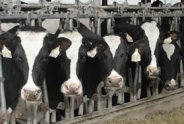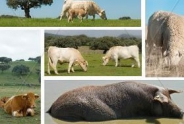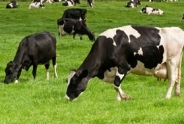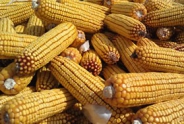Forages
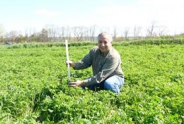
2025 Growing Degree Day Summaries for 4 Representative weather stations
Janice Degni, Team Leader, Field Crop Specialist
South Central New York Dairy & Field Crops
Silage inoculants: What the research tells us about when and how to use them
Considerations for the role of an inoculant in a year with a wide range of crop maturity.
USDA to Provide More Than $3 Billion to Commodity and Specialty Crop Producers
WCM: Session 2-Key Considerations Feeding 2021 Corn Silage and Planning for 2022
Donette Griffith, Administrative Assistant
South Central New York Dairy & Field Crops

Resources from Winter Crop Meeting 2022: Session 2 (January 21)
Topic: Key Considerations Feeding 2021 Corn Silage and Planning for 2022 with Joe Lawrence
Slides and links available
Fall Alfalfa Management - Dr. Jerry Cherney updated 2021
Janice Degni, Team Leader, Field Crop Specialist
South Central New York Dairy & Field Crops
2018 Feed Dealer Seminars
Tatum Langworthy, Sr. Administrative Assistant
South Central New York Dairy & Field Crops
A Comparison of Pre & Post Tassel Fungicides for the Control of NCLB
Janice Degni, Team Leader, Field Crop Specialist
South Central New York Dairy & Field Crops
Northern Corn Leaf Blight (NCLB) is one of the most serious diseases of corn. It has become endemic in NYS, affecting all corn growers. Although we cannot predict when first infection will occur, it has occurred regularly for over ten years consecutively. This field scale study sought to measure and compare effects on yields and quality from fungicide treatment at an early and late timing on five cooperating farms in Northern, Central and Eastern New York. Applications were made at two timings: early vegetative and reproductive. Treatments included: 1) an untreated control, two early vegetative fungicide treatments with
2) Priaxor® and 3) Affiance®, and two post tassel treatments of 4) Affiance® and 5) Headline Amp®. This year was an anomaly because occurrence was absent to arriving fairly late and then only with light infection. NCLB disease incidence was very low, below 1% in the majority of the plots. Although disease pressure from common rust was abundant as well as other abiotic stress factors, there were no statistically significant effects on yield or forage quality components from the fungicide treatments compared to the untreated check plots.
First Cutting Updates - Week of May 22nd, 2018
Betsy Hicks, Area Dairy Specialist
South Central New York Dairy & Field Crops
An overall assessment of first cutting growth from fields we measured:
Quite a few farms across the region have started harvest of pure grass stands, as well as mixed stands. Recommendations are for 50% or less alfalfa stands to make prudent use of this cutting window to harvest for peak dairy quality across the region. There is still time for pure alfalfa stands to gain yield, given Jerry Cherney's observations. Look for our final report on Wednesday, May 30th. We will be sending out a brief survey of how you use the reports, so please feel free to give your assessment of how we are doing in regards to timing of first crop. You can also reply to Betsy with any comments you may have on the use of the report or how we can improve.
In the meanwhile, stay safe out in the fields and update the team with any conditions you encounter that would be of interest.
First Cutting Updates - Week of May 29, 2018
Betsy Hicks, Area Dairy Specialist
South Central New York Dairy & Field Crops
An overall assessment of first cutting progress from fields we measured: Most fields we measure have been harvested or are in the process of being cut. Early samples we've gotten back have shown that grass cut on recommendations looks really nice. One all grass sampled showed Adj Prot 22.0%, NDF 53.2 and NDFD 30h at 76. Early grass varieties are well headed by now, but later maturing grasses are just to head stage. If you have alfalfa fields standing alongside grass fields, it may be a good idea to harvest the grass for heifer or dry cow haylage, and focus on getting your alfalfa crop for lactating quality. Most alfalfa fields still standing are showing signs of early bud. A sample we've gotten back on a mostly alfalfa field cut on recommendations showed Adj Prot 22.6%, NDF of 48 and NDFD at 66, with the NDF and NDFD numbers a bit surprising. We'd like to see more samples of both grass and alfalfa and mixed if you'd like to share with Janice or Betsy.
First Cutting Updates - Week of May 15th, 2018
Betsy Hicks, Area Dairy Specialist
South Central New York Dairy & Field Crops
An overall assessment of first cutting growth from fields we measured:
Now is the time to cut Pure Grass fields across the region for peak dairy quality forage. Some higher elevations are just at that point, some fields in lower elevations and those in the southern portion of the region are just past that point. Weather forecast looks like rain over the weekend. If you have pure grass stands to harvest for your lactating cows, now is the time to park the corn planter and focus on quality hay crop. For 50/50 mixed stands, recommendations are looking like middle of next week for peak quality. Pure alfalfa stands we still have time - predictions are out to the end of the month at this point for peak quality. Please feel free to share samples you have analyzed with the team to let us know how predictions match up with reality.
First Cutting Updates - Week of May 8th, 2018
Betsy Hicks, Area Dairy Specialist
South Central New York Dairy & Field Crops
An overall assessment of first cutting growth from fields we measured:
Many stands of alfalfa are too short to give adequate predictions for pure grass stand harvest - especially those at higher elevations. That being said, many lower elevation fields have alfalfa measuring 11-12", and predictions for harvest of nearby pure grass fields look like this weekend for peak quality. 50/50 mixed grass/alfalfa stands predictions are saying harvest in ~2 weeks, but time and weather will give us a better prediction next week for mixed stands. Weather looks like rain on Saturday, but a decent stretch of weather to start next week out. Look for our next report on Wednesday, May 16th. In the meanwhile, stay safe out in the fields and update the team with any conditions you encounter that would be of interest.
What is the potential NDFd of 2017 corn silage?
A message from Kevin Putnam, Dairy Specialist with Dupont-Pioneer
Upcoming Events
Winter Bale Grazing Pasture Walk
January 10, 2026
Truxton, NY
Join us for the second Bale Grazing Winter Pasture Walk!
Have you heard about or seen bale grazing and wondered if it would work for you?
Do you want to learn the nuances and logistical context for implementing this regenerative practice?
Are you interested in seeing the impacts of bale grazing on land and animals from a practicing farmer?
If you answered Yes to any question, The Northeast Region National Grazing Lands Coalition, the Cornell Cooperative Extension Hillside Farms are teaming up to showcase our Second Bale Grazing Winter Pasture Walk!
2026 Winter Crop Meeting
January 22, 2026
Ukrainian National Club , Auburn,
Connect with the agricultural community and many key note speakers on the folllowing topics:
- Emerging Innovation in Plant Breeding and Technologies - A Peek at the Future by Ben Rogers, Pioneer Field Agronomist
- Managing Herbicide-Resistant Weeds in NY Corn & Soybean by Dr. Vipam Kumar, NYS Extension Weed Scientist, Cornell University
- Livestock Risk Protection (LRP) Insurance Program by KC Slade, Risk Management Specialist, Farm Credit East—Crop Growers
- Birds & the Bees Legislation and the Fate of Neonics by Janice Degni, Extension Field Crop Specialist
- Emerging Disease Pests and Soil Borne Diseases of Soybean by Dr. Camilo Parada Rojas, NYS Extension Plant Pathologist, Cornell University
- Solar Farms—Benefit or Detriment? by Mr. Michael McMahon, Chair, Homer Town Planning Board
4 DEC credits - CCA credits available
Cost TBA
2026 Winter Crop Meeting
January 23, 2026
Dryden VFW, Dryden, NY
Connect with the agricultural community and many key note speakers on the folllowing topics:
- Emerging Innovation in Plant Breeding and Technologies - A Peek at the Future by Ben Rogers, Pioneer Field Agronomist
- Managing Herbicide-Resistant Weeds in NY Corn & Soybean by Dr. Vipam Kumar, NYS Extension Weed Scientist, Cornell University
- Livestock Risk Protection (LRP) Insurance Program by KC Slade, Risk Management Specialist, Farm Credit East—Crop Growers
- Birds & the Bees Legislation and the Fate of Neonics by Janice Degni, Extension Field Crop Specialist
- Emerging Disease Pests and Soil Borne Diseases of Soybean by Dr. Camilo Parada Rojas, NYS Extension Plant Pathologist, Cornell University
- Solar Farms—Benefit or Detriment? by Mr. Michael McMahon, Chair, Homer Town Planning Board
4 DEC credits - CCA credits available
Cost TBA
Announcements
USDA Contract Freezes and Terminations: Legal Action Steps for Farmers
For Farmers with Signed EQIP and CSP ContractsThis resource is written for farmers and ranchers nationwide who have a signed contract with USDA NRCS under the EQIP or CSP program for environmental improvements but have concerns that their contract is frozen, under review, or terminated, and who are uncertain of their rights to receive reimbursement as well as their ongoing obligations under the signed contract.
Version: 1.0
Issue date: Feb 28, 2025
A downloadable factsheet is available at our BUSINESS tab on the top of our webpage.
Additional Information: www.farmcommons.org
USDA Contract Freezes: Filing an NAD Appeal or Demand Letter
This resource is written for farmers and ranchers nationwide who have a signed contract with USDA NRCS under the EQIP or CSP program for environmental improvements and want more information on the mechanics of filing a National Appeals Division (NAD) appeal. This resource includes sample letters.
USDA NAD Appeal https://www.usda.gov/about-usda/general-information/staff-offices/office-hearings-and-appeals/national-appeals-division/nad-appeals
Farm Participants Needed for Bale Grazing Grant!
Information on the Project:- Approximately 10 acres total needed to bale graze two different bale densities
- "Core" farms will graze two winters, "Demo" farms will graze one winter.
- Payments for both "Core" farms and "Demo" farms
- Baseline soil sampling by bale grazing team
- Forage measurements in early season by bale grazing team
- Late season clipping if residual not trampled down by farm
Cornell Cow Convos - New Podcast
On-going podcast, New episodes released on the last Thursday of the month.Guest speakers, CCE Dairy Specialists.
Housed on Soundcloud Channel is CCE Dairy Educators
- Preventative healthcare for cows
- The trend of beef on dairy
- What to look forward to in the new year for dairy
- Socially grouping or pair-housing calves
2018 Drug Residue Prevention Manual
For more than 30 years, the U.S. dairy industry has focused educational efforts on the judicious use of antibiotics through the annual publication of a Best Practices Manual. The 2018 edition of the National Dairy FARM Program: Farmers Assuring Responsible Management? Milk and Dairy Beef Drug Residue Prevention Manual is the primary educational tool for dairy farm managers throughout the country on the judicious and responsible use of antibiotics, including avoidance of drug residues in milk and meat.The manual is a quick resource to review those antibiotics approved for dairy animals and can also be used as an educational tool and resource for farm managers as they develop on-farm best management practices necessary to avoid milk and meat residues. Visit the Manual and Form Library to download copies of this important tool!
Follow us on Facebook
The team updates our facebook page frequently - follow us to be updated on our events, see some fun videos and get local area updates!facebook.com/SCNYDairyandFieldCropsTeam
NYSERDA Agriculture Energy Audit Program
NYSERDA offers energy audits to help eligible farms and on-farm producers identify ways to save energy and money on utility bills. Reports include recommendations for energy efficiency measures.For more information and the NYSERDA Agriculture Energy Audit Program Application click here

